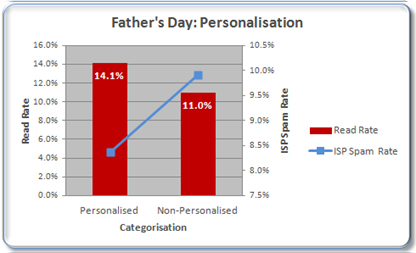In a recent survey by the Netmums online forum, growing alarm was revealed about the way that Dads are portrayed in children’s TV shows. The major culprit is Peppa Pig’s dad, who is depicted as unshaven, overweight and generally hopeless. He is closely followed by Fred Flintstone and Homer Simpson, both lampooned as “bungling fools.”
Sadly, this perception of Dads appears to be reflected in their treatment at Father’s Day. Another recent study conducted in the US by the National Retail federation, showed that the average spend on Mother’s Day exceeds that for Father’s Day by a full 40%!
The same research also reported that 3 in 10 respondents planned to shop online this year, meaning that email program performance for brands planning on taking advantage of this purchasing trend was going to be more important than ever. So we thought that we would use Return Path’s subscriber engagement data to see how successful they were, and whether Dads – just for once – could enjoy their spot in the limelight!
The first thing that we had a look at was whether ungrateful sons and daughters attempt to purchase their Dad’s presents on the cheap. We evaluated whether Father’s Day emails that carried an offer for money-off (“Free”, “Save”, “Sale”, “% Off”) were more effective than those that didn’t:
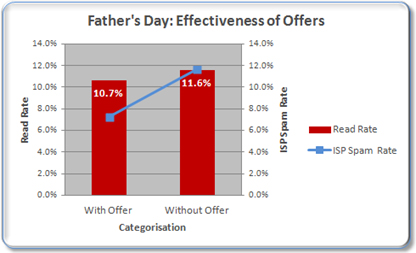
Pleasingly, this turned out to not be the case, with these emails on average performing around 10% worse in terms of the Read Rates that they generated. Interestingly, the emails with the higher Read Rates were also mirrored by higher ISP spam rates, perhaps suggesting that emails containing an offer are more specific, while the more generic emails generated higher complaint rates when respondents didn’t find what they were looking for.
Reassuringly, the idea that Dads aren’t getting short-changed on Father’s Day is reinforced by the way that email recipients respond to discounted offers. Where the emails contained a deal of this type (“Save 50%”, “25% off”, etc) we categorised them as “Small” (<50%) or “Large” (>=50%).
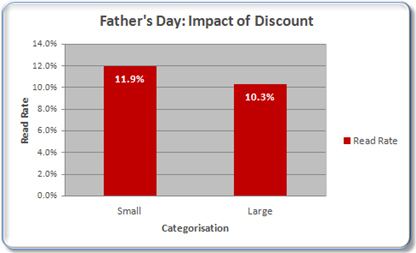
Father’s Day shoppers are clearly not just seeking out the cheapest deal that they can get away with. This also supports a broader concept that we have seen before, with consumers being distrustful of large discounts, and responding in greater numbers to smaller discounts, perhaps because they are both more believable and more attainable.
However, it’s not all good news for Dads. The next example illustrates the fact as special days go, it’s not exactly front of mind and subscribers are clearly more disposed to respond when they are explicitly reminded when it actually happens. Here, we are comparing subject lines containing the date (“June 16”) with those that don’t.
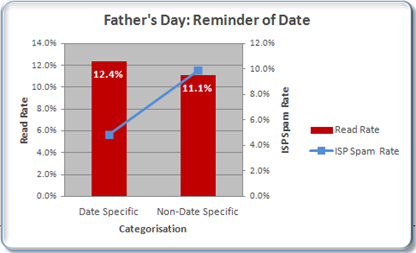
Note how the ISP Spam rate increases significantly where the date is not used. This may imply that subscribers are less likely to respond to these emails until it is already too late. Once Father’s Day has already passed, these emails will have absolutely no relevance and Spam Complaints and Deleted Unread metrics will rise as a result.
One unexpected learning involved the use of “Father’s Day” itself as part of the emails’ call to action. We noticed that in many instances (around 5% of the total sample) this text was incorrectly punctuated (“Fathers Day”) so we examined whether this had an impact on response rates.
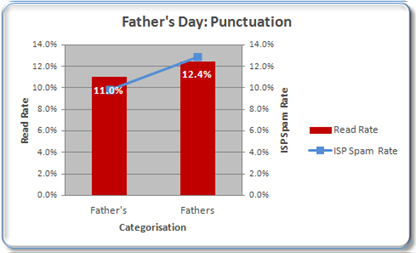
Sadly, and perhaps reflecting that we are now firmly in the age of text-speak, Read Rates were actually higher for the incorrect version. However, ISP spam rates for these emails were almost 1/3 higher too, suggesting that inbox providers view this as a possible indicator of non-legitimate emails.
Personalisation also continues to play an effective role. Read Rates were materially higher, and ISP Spam rates lower, when this approach was employed as part of Father’s Day email subject lines, although this was only done for 6% of the total sample data set.
So from Return Path’s overall pool of subscriber data we have learnt that Dads are not being short changed by their cheapskate kids (although they do need a reminder of when the big day is!) and it appears that the ISPs are advocates of genuine Father’s Day activity. We then thought that it would be interesting to look at a sector that appeals to the small boy who lives in every Dad’s heart – gadget shops! So we pulled data from 5 major UK gadget providers to see how their email programs performed in the run-up to Father’s Day.
We can see that Father’s Day is a big month for the Gadget shops. Using an index where 100 represents normal monthly activity, we can see that the number of campaigns, and the amount of volume sent, increases by over 50% for this sector.
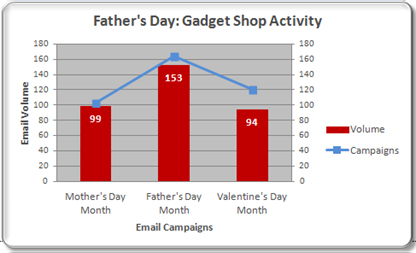
A question that is frequently asked about email programs that have seasonal biases is whether these periodic upshifts in activity have a negative impact on subscriber engagement. There is a school of thought in some email marketing circles that “send more email” is the route to success because it will generate more gross email opens. However, this approach ignores the offset that is caused by higher complaint rates and delete activity. This expedites subscriber churn and changes in a marketer’s email address list.
There is definitely a relationship between frequency and responsiveness, and we have demonstrated it by splitting the Gadget Shop senders into “Lower Frequency” (4 campaigns or less per month) and “Higher Frequency” (more than 4 campaigns per month, typically 3-4 campaigns per week). We can see from the following graph that the lower frequency senders typically generate Read Rates that are almost twice as high as the higher frequency senders, while their ISP Spam rates are typically only 2/3 those of the higher frequency senders.
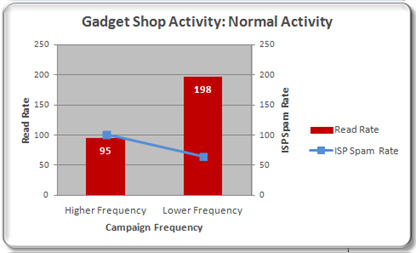
However, Father’s Day provides us with an interesting variation on this hypothesis.
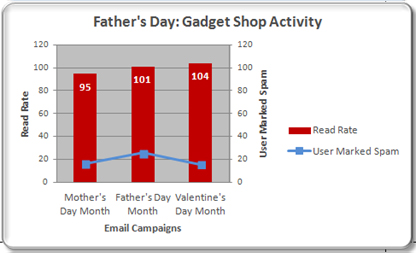
At first glance, this graph may elicit a response of “so what?” Admittedly, Read Rates have only increased very slightly against the monthly norm. However, remember that volumes have increased by 50% so gross opens are significantly higher, meaning more sales! Also, user marked spam rates are only around 1/5 of the monthly norm, demonstrating that subscribers are more responsive to higher levels of email activity during these periods. So you can occasionally send more, with the important caveat that you need to know when your subscribers will be most receptive to this upshift.
In analysing Gadget Shops’ email activity in the run-up to Father’s Day, it was also very noticeable that this sector’s activity declines noticeably during the Valentine’s Day and Mother’s Day periods. No surprise there – other less “gadgety” senders would have been effectively competing for mindshare then.
However, there was one noticeable exception in the form of the online store “Presents for Men”, which ran counter to the otherwise strong trends that we have been analysing, and was initially puzzling:
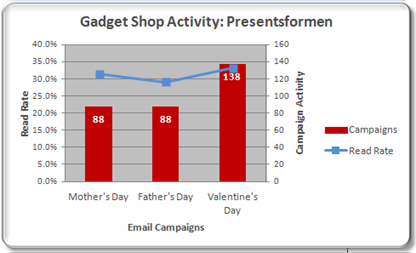
We hypothesised that maybe there was a different audience profile here. In the earlier NRF survey that we referenced, Father’s Day shoppers were also purchasing for husbands (29.1%), sons (9.7%), brothers (6.4%), friends (5.4%), and grandfathers (4.9%). We were right, because “Presents for Men” also includes “Gifts for the Girls” – which kind of reinforces our earlier hypothesis that Dad’s invariably come off second best in email marketing and online shopping.
Two of the largest email programs in this sector are those of Firebox and IWantOneOfThose (IWOOT). Below, we evaluate how these competitors perform on a head-to-head basis.

It can be seen (on the right) that IWOOT has an email list size that is 1.6 times larger than Firebox’s. Interestingly, there is a relatively small overlap between the two subscriber audiences, implying that there is a strong degree of brand loyalty present. For those subscribers who do fall within the overlap, there is a slight bias in response rates in favour of IWOOT.
One potential reason for this is that the two programs operate markedly different broadcast profiles. As the following graphic shows, IWOOT focuses of Fridays and Sundays while Firebox favours Mondays, Thursdays and Saturdays. Both senders see a drop-off in Read Rates over the weekends.
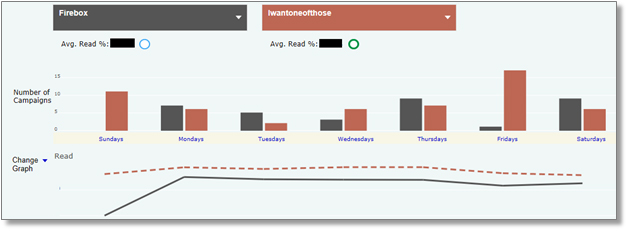
What else did we learn from Father’s Day? There was definitely a sprinkling of the good, the bad, and the ugly so I thought I’d finish with a few specific examples to bring some important principles to life:
1. The Good!
IWantOneOfThose probably wanted to break the tedium of “Don’t Forget Good Old Dad” so they sent out this as well:

As a huge Star Wars fan I thought that this was very funny. So did most of IWOOT’s other customers who received this email, as can be seen from this comparison of the 3 email messages they sent out on that day.
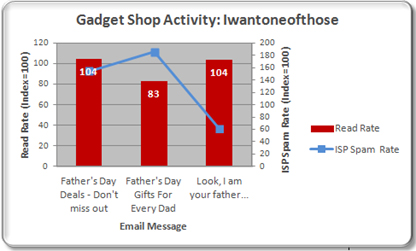
Note the ultra-low ISP Spam Rate for the “Look” email – a clear sign that it resonated with its recipients in terms of positive subscriber engagement. Interestingly, Wowcher took a near identical approach to an email that it sent to one of my colleagues:
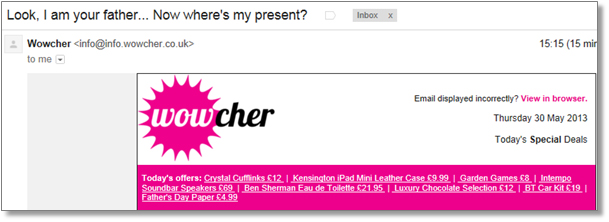
By her own admission she is a self-confessed Star Wars “Luddite” and she thought it was a bit stupid, so definitely a case of “know your audience!”
2. The Bad!
Earlier in this article, we referenced the importance of timing for seasonal campaigns. The moment that an email is read and an event has already passed, the email has no relevance, and spam complaint and deleted unread activity ramps up significantly as a result.
One of my colleagues sent me an email that she received from Zadig & Voltaire which illustrates this principle beautifully:
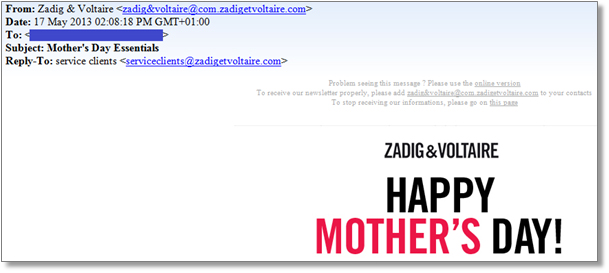
There are two major problems here:
- My colleague is registered as a UK customer. For her, Mother’s Day was on March 10th.
- Even if she had been a US customer, the correct date was May 12th!
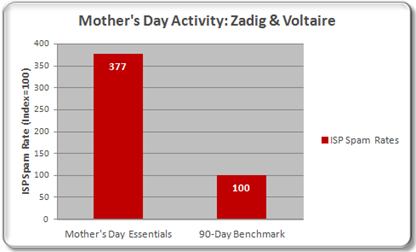
Not unsurprisingly, Z&V customers voted with their spam and delete buttons, resulting in ISP Spam Rates that were almost 4 times higher than their 90-day average.
3. The Ugly!
Sadly, the blight of spam affects Father’s Day too. One of my colleagues received the following intriguing example:

These emails originate from a sender called Gregado.com. We can see how effective these emails are from the below data analysis:

It’s easy to look at this data and think that there isn’t really a problem – ISP filtering is largely doing its job, and average Read Rates are relatively low. However, the reality is that these spammers have a list of between 10M and 15M addresses. We can also see that this list is being emailed an average 4.5 times per day.
A recent report by Cisco Systems reported that there is an average of 8 victims per 1M emails sent, with an average cost per victim of £160 in the form of personal information yielded or malware installed. If we look at the average list size and say 12.5M, then we are looking at around 13,700 victims per month at a total cost of £2.2M.
So now we’ve come full circle. Learnings from this article are that Dad’s are not yet completely victimised, and email engagement metrics suggest that their families and loved ones are still doing the right thing when it comes to Father’s Day. In fact, when Dad’s are allowed to roam in their natural environment (Gadget Shops) they are clearly thriving. Perhaps it’s a case of letting them get on with doing what they do best. Then the comparisons will seamlessly shift away from Peppa Pig’s Dad towards worthier role models. Right now I’m thinking of Bob Parr, aka Mr Incredible . . .
